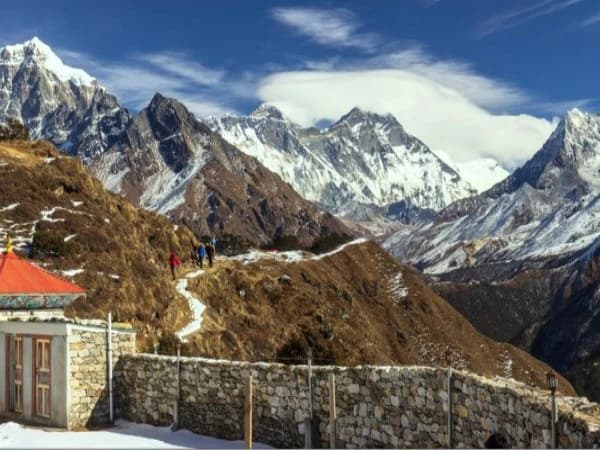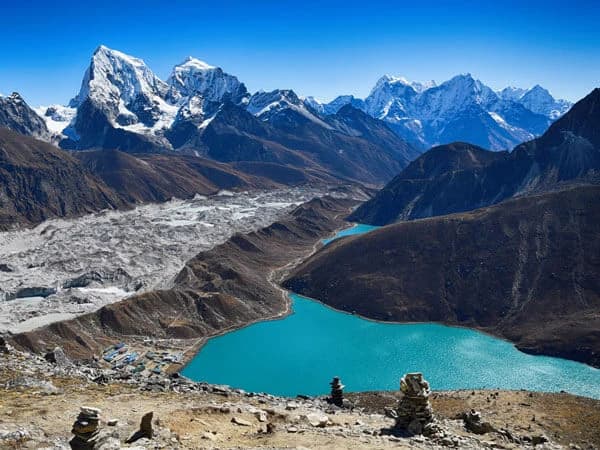The Everest Base Camp Trek is a journey through remote areas on Earth. It offers stunning Himalayan views and a chance to experience a unique blend of nature and adventure. One of its attractions is the diverse range of wildlife.
The Everest Region allows you to explore its diverse flora and fauna. At lower elevations, you'll encounter lush rhododendron forests vibrant with spring blooms and pine forests. Wildlife is equally fascinating, with the major highlights being the Himalayan Tahr and Snow Leopard.
On the lower slopes, the Red Panda adds a splash of colour, while various bird species, like the vibrant Himalayan Monal, and unique animals, such as the Himalayan Pika, enhance the trek's natural beauty. Explore more about Wildlife in Everest Base Camp Trek in our comprehensive guide.
What Animals Live on Mount Everest?
Mount Everest is located in the Himalayas on the border between Nepal and the Tibet Autonomous Region of China. Mount Everest’s frozen cold atmosphere and harsh conditions create a challenging environment for wildlife. Despite the extreme cold and high altitude, various animals have adapted to survive in this rugged terrain.
Here are some of the key species:
Snow Leopard
The Snow Leopard is among the Everest region's most rare and beautiful animals. It is also called the "Ghost of the Mountains," a very rare and endangered big cat.
They are found in the upper reaches of the Himalayas at elevations between 3,000 and 4,500 m, including the areas around Everest. They prey on animals such as Himalayan tahr and blue sheep. The snow leopard is well adapted to high altitudes and harsh climates because its thick fur and significant nasal passages help it breathe the thin air. The large paws enable it to go up snowy slopes with ease. Their long, thick tail is a fat reserve for them and helps them balance on rugged ground.
Himalayan Black Bear
Although the Himalayan black bear forms part of the region's ecosystem, it is seldom spotted. It is generally found in tropical forests at lower altitudes from 1,500 meters and above, preferring forested areas where it can search for food.
Its diet includes fruits, insects, and small mammals. Its thick black fur acts like a warm coat, protecting it from the cold. In summer, it moves to warmer areas, which enhances its adaptability and strength. Despite their rare sightings, these bears contribute to the biodiversity of the Everest region.
Himalayan Tahr
The Himalayan Tahr is a large herbivore inhabiting the steep, rocky slopes of the Everest region. This range lies between 2,500 to 4,000 meters (8,200 to 13,100 feet). Its thick, reddish-brown fur serves to insulate against cold and its strong hooves aid in providing the required support on these mountain ranges. Their strong claws are adapted for climbing trees and digging.
The male Himalayan Tahr is usually larger than the female, averaging about 73 kg or over in weight. The Tahr feeds on grasses, shrubs, and other vegetation in its alpine habitat.
Himalayan Goral
The Himalayan Goral is a goat antelope found in Everest's rocky, hilly areas and cliffs. It lives at 2,000 to 3,500 meters (6,500 to 11,500 feet).
These large, goat-like animals have thick reddish-brown fur to keep them warm in these cold environments. Keen eyesight and alert natures help them detect the presence of predators, such as Snow Leopards, at a distance.
Their powerful hooves are adapted to climb rocky terrain. Being herbivorous, they eat grasses, shrubs, and other vegetation in their alpine home.
Red Panda
The Red Panda is mainly found in the lower altitudes of the eastern Himalayas and can be traced within the Everest region. They will prefer a dense forested area with much bamboo; in the Everest area, their location would be on lower slopes of forests, which span around 2,200-4,800 meters (7,200-15,700 feet).
The red panda is a very arboreal animal, mostly seen on trees. Their reddish-brown fur and playful nature make them highly recognizable. The bushy tail and special wrist bones that substitute for thumbs help them in climbing and finding food. Their diet mainly consists of bamboo, fruits, small mammals, and insects.
Bharal (Blue Sheep)
The Bharal, also known as the Blue Sheep, is an essential herbivore in the Everest region. They are typically found on steep, rocky slopes and alpine meadows between 3,000 and 5,000 meters (9,800 to 16,400 feet).
These animals are well adapted to high altitudes and rugged terrain, and their blue-grey fur is one of the most distinctive features. They are an essential food source for predators like snow leopards and play a vital role in the ecosystem. Bharal primarily feeds on grasses, herbs, and other vegetation available in their high-altitude environment.
Wild Yak: The Everest Icon
The Wild Yak is an iconic species of the Everest region found at altitudes from 4,000 to 6,000 meters (13,100 to 19,700 feet). Its thick, shaggy coat protects it from extreme cold. Its large, muscular body and strong legs are adapted for carrying heavy loads and navigating rugged terrain.
They are crucial for the local economy and culture, providing transportation and resources for the people living in high-altitude areas. Wild Yaks are herbivorous and graze on grasses, lichens, and shrubs.
Mountain Weasel
The Mountain Weasel is a fascinating and rare resident of Everest’s high-altitude terrains. Its sleek, elongated body perfectly adapts to the rugged environment, effortlessly slipping between rocks in search of prey.
This small predator hunts primarily rodents, birds, and insects, using sharp teeth and agility to catch prey. The Mountain Weasel's fur changes color in different seasons, serving as effective camouflage from both predators and prey. In winter, the coat is white, while in summer, it wears a brownish colour. It helps control the populations of small mammals and thus strikes a balance in the ecology.
Himalayan Pika
The Himalayan Pika is small and rabbit-like and lives at the high altitude of Everest, between 3,000 and 4,800 meters (9,800 to 15,700 feet). It is known for its high-pitched calls and role in the ecosystem as a prey species for larger predators. The pika's diet consists mainly of grasses and other plant material.
Pikas are small mammals with rounded bodies, short legs, and dense fur that keeps them warm. They are well adapted to surviving in extreme high-altitude conditions. They are herbivorous and feed on grasses, herbs, and leaves.
Yellow-Throated Marten
The Yellow-Throated Marten is a relatively rare predator found in the forested areas of the Everest region, generally from 2,500 to 4,000 meters (8,200 to 13,100 feet).
Its distinctive yellow throat patch and agility make it enjoyable. The marten preys on small mammals, birds, and insects and contributes to the area's biodiversity. It has a distinct yellow throat patch with an elongated, bushy tail. Its agile body with sharp claws was adapted for climbing and hunting. Various small animals, including rodents, birds, and insects, comprise its diet.
What Birds live on Mount Everest?
Himalayan Monal
The Himalayan Monal, also known as daphne in Nepali, is Nepal's national bird. It is found in forested areas and alpine meadows, usually at 2,400 to 4,500 meters (7,900 to 14,800 feet).
It is a pretty big pheasant with shades of green, blue, and red, making it a striking sight in the Everest region. Its striking appearance helps it blend into its colourful surroundings. Himalayan Monals primarily feed on seeds, insects, and small plants.
Blood Pheasant
The Blood Pheasant is a striking bird with its red plumage. It prefers open, rocky, and alpine areas at elevations from 3,500 to 5,000 meters (11,500 to 16,400 feet) and is adapted to the cold climate of Everest. It can be found in the forested lower elevations, typically between 2,500 and 4,500 meters (8,200 to 14,800 feet).
They have a distinctive red and white plumage, robust body, and strong legs. It has bright blue plumage with a contrasting black head that provides visibility and camouflage. Its strong legs and sharp beak aid in hunting.
Grandala
The Grandala is a colourful bird generally found in the higher altitudes of the Everest region, between 3,500 and 5,000 meters (11,500 to 16,400 feet). Its bright blue plumage with a contrasting black head serves both as visibility and camouflage. Strong legs and a sharp beak help the Grandala search for food. It feeds on insects and berries, adding to the diversity of the bird species in the region.
Tibetan Snowcock
The Tibetan Snowcock is a vast bird inhabiting the highlands of the Himalayas at elevations of usually around 3,500 to 5,000 meters above sea level (11,500 to 16,400 feet above sea level). It will have adapted well to Everest's cold climate through the thick plumage against such hostile climates, with powerful legs facilitating locomotion through the rocky terrain. They possess a fully equipped body and feathers that very strongly disguise them into their natural background.
They feed on seeds, berries, and insects. Though rare, the Tibetan Snowcock adds to the variety of the area's bird life. The Grandala, through its role in seed dispersal and insectivorous habits, adds to the biodiversity of the Everest ecosystem.
Golden Eagle
The golden eagle is one of the largest birds of prey in the Himalayas. It ranges from 2,000 to 5,000 meters (6,500 to 16,400 feet) and inhabits various high-altitude regions, including the Everest area. It enjoys an immense wingspan and sharp eyesight, which it uses to hunt small mammals and birds. The golden eagle shows strength and majesty in the Everest ecosystem.
They have a strong build with dark brown feathers and large wingspans, apt for soaring and scanning the prey. Their talons and beak are adapted for hunting.
How Do Mount Everest Animals Survive the Cold?
Animals in the Everest region developed various adaptations to cope with the extreme cold and low oxygen levels. Such adaptations include:
- Thick fur and feathers: Many animals, such as the Wild Yak and Snow Leopard, possess thick fur or feathers that insulate them from cold.
- Large lungs and heart: The large lungs and hearts, such as in the Snow Leopard, are useful for survival in a high altitude with thin air and low oxygen levels.
- Specialised metabolism: Animals like the Himalayan Tahr have a slow metabolism that conserves energy during hard times.
- Behavioral Adaptations: Some animals, like the Red Panda, spend most of their time on trees to avoid cold grounds and predators.Snow Leopard
Recommended Read
How Cold is Mount Everest
Common Plant Species
The flora in the Everest region is adapted to the extreme conditions no differently than its fauna. The typical plant species of this area are:
Rhododendron
Rhododendron is a genus of flowering plants in the heath family Ericaceae. It is the national flower of Nepal. Rhododendrons are shrubs and small trees recognized by their showy, funnel-shaped flowers, ranging from pink to red, purple, or white. They are famous in ornamental gardening for their attractive blooms and evergreen leaves.
Juniper
Junipers are evergreens that populate the woodlands of the Himalayan region. They have needle-like leaves and berry-like cones, being widely distributed throughout the Northern Hemisphere. Junipers are appreciated for their fragrant wood and foliage, used in perfumes, essential oils, and culinary traditions. The berries of some species are also a key ingredient in gin production.
Himalayan Birch
The Himalayan Birch is distributed in the subalpine and alpine zones of the Himalayas and thrives in cold, high-altitude environments. It is known for its striking white bark peeling in thin, papery layers, historically used as a writing material in ancient India and Nepal. For the same striking appearance, it is cultivated for its ornamental values in landscaping.
Edelweiss
Edelweiss is a small perennial adapted to survive in harsh, rocky environments at high altitudes. Its star-shaped, white, woolly flowers are easily recognizable and give it a unique, fuzzy look. Edelweiss is often associated with rugged beauty and purity, and it has cultural meaning in Alpine countries, where the plant is a symbol of national pride.
Snow Lotus
The Snow Lotus is an extraordinary and rare plant that grows in the high, cold reaches of the areas surrounding Everest. It is a hardy plant that has adapted to survive on rocky, windswept ground. It has thick, woolly leaves that conserve moisture and protect it from freezing temperatures. The plant's striking flowers are usually pale purple or white, and they bloom amidst the snow, creating a stunning contrast against the barren landscape.
Impact of Climate Change on Everest Wildlife
It is important to note that the changing climate has seriously affected the wildlife in Everest Base Camp Trek. The increased temperature alters the habitats and behavior of animals. High-altitude species are losing their natural habitats, which forces them to shift to higher elevations or adapt to new conditions. With the alteration of vegetation, the food supply of herbivores like the Himalayan Tahr and Bharal is disturbed.
As animals move out of their habitats, they might find increased competition for the available resources, hence struggling to survive. In this changing environment, conservation of biodiversity and maintenance of resilient ecosystems depend on sound conservation efforts. These range from the establishment of protected areas to conducting studies to comprehend the particular impacts, thereby proposing strategies to mitigate the adverse effects.
To Sum Up
The wildlife of the Everest Base Camp Trek offers a fascinating glimpse into the resilience and adaptability of life in one of the world’s most extreme environments. From the majestic Snow Leopard to the vibrant Himalayan Monal, the animals of Everest are an integral part of the region’s rich biodiversity. Understanding and protecting these species, including the diverse wildlife in Everest Base Camp Trek, is crucial as climate change and other threats continue to impact their habitats.
Explore Everest Region Trekking Packages
- Everest Base Camp Trek via Cho La Pass & Gokyo Lakes - 19 Days
- The Everest View Luxury Lodge Trek - 8 Days
- Everest Three High Passes Trek -22 Days
- Everest Base Camp Trek with Island Peak Climb - 19 Days
- Everest Base Camp Short Trek - 10 Days
- Gokyo Valley Trekking - 14 Days
- Everest Panorama Trek - 9 Days
FAQs
What animals live in Everest Base Camp?
Everest Base Camp is home to various wildlife, including the Himalayan Tahr, Blue Sheep, and different bird species. However, larger animals like Snow Leopards are less commonly seen in the base camp area.
Has an animal ever climbed Everest?
No, but some animals, like yaks and horses, are used to carry supplies and equipment to higher camps.
Can birds reach Everest?
Some bird species can reach high altitudes, including the Tibetan Snowcock and golden eagle, which are found in the Everest region.
Do snow leopards live on Mount Everest?
Snow Leopards inhabit the higher elevations of the Everest region, but they are rarely seen due to their elusive nature.
Does anyone survive on Everest?
While climbing Mount Everest is challenging and dangerous, many climbers reach the summit each year; though conditions are harsh, only some survive the attempt.
Explore our blog to learn how hard is the Everest Base Camp trek.
Which animals live at the highest altitude?
The highest-altitude animals in the Everest region include the Snow Leopard and the Himalayan Pika, which have adapted to survive in extreme conditions.
What are the dangerous animals on Mount Everest?
Some of Mount Everest's most dangerous animals include the Snow Leopard, known for its powerful hunting skills, and the Himalayan Black Bear, which can be aggressive if threatened.



-(1200-x-675-px)-compressed.webp&w=3840&q=75&dpl=dpl_CtNAyRzUAwPdWKDCFxYk5p2VryPh)







-(5).webp&w=1200&q=75&dpl=dpl_CtNAyRzUAwPdWKDCFxYk5p2VryPh)
